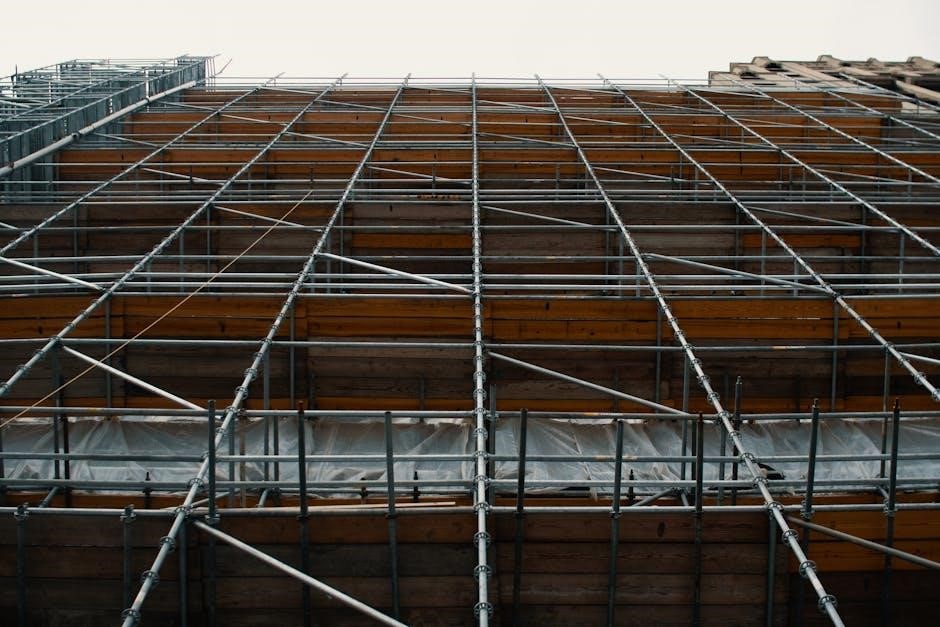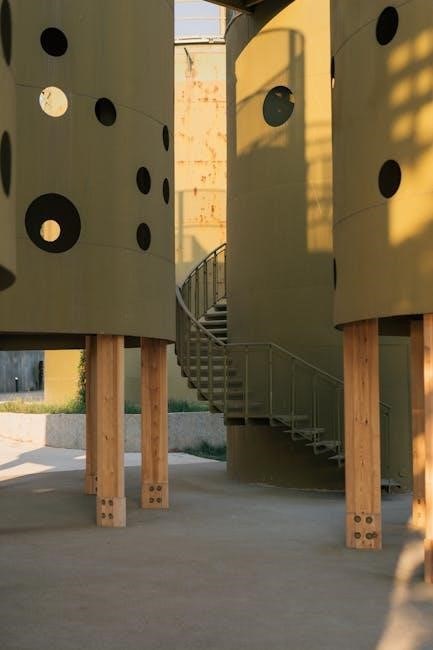Wood heaters are a popular heating solution in Australia, offering warmth and efficiency. Correct installation is crucial for safety, efficiency, and compliance with Australian Standards like AS/NZS 2918.

Australian Standards for Wood Heater Installation
Australian Standards for wood heater installation are governed by AS/NZS 2918, ensuring compliance with safety, efficiency, and environmental requirements. Professional installation is mandatory for legal and operational compliance.
2.1 Compliance with AS/NZS 2918
Compliance with AS/NZS 2918 is essential for ensuring the safe and efficient installation of wood heaters. This standard outlines specific requirements for clearances, chimney construction, and hearth installation. It mandates that wood heaters must be installed at least 300mm away from rear walls and 500mm from side walls to prevent fire hazards. Additionally, chimneys must be constructed with durable materials and properly lined to withstand high temperatures. The standard also requires regular testing and certification to ensure heaters meet safety and emission standards. Adhering to AS/NZS 2918 is not only a legal requirement but also crucial for maintaining operational efficiency and minimizing environmental impact. Always consult the standard or a licensed installer for precise compliance.
2.2 Key Clauses and Provisions
AS/NZS 2918 outlines key clauses to ensure safe and efficient wood heater installations. These provisions include mandatory clearance distances from combustible materials, such as walls and ceilings, to prevent fire risks. The standard specifies that wood heaters must maintain a minimum distance of 300mm from rear walls and 500mm from side walls. Additionally, it requires hearths to be constructed from non-combustible materials and chimneys to be built with durable, heat-resistant components. The standard also emphasizes proper ventilation and airflow to optimize performance and reduce emissions. Compliance with these clauses is critical to ensure safety, efficiency, and adherence to legal requirements. Regular inspections are recommended to verify ongoing compliance.
2.3 Testing and Certification
Testing and certification are essential steps in ensuring wood heaters meet Australian safety and performance standards. All wood heaters must undergo rigorous testing to comply with AS/NZS 2918, which evaluates factors such as heat output, emissions, and safety features. Certification involves third-party verification to confirm that the heater meets specified standards. Manufacturers must provide test reports and certification documents to demonstrate compliance. Additionally, heaters are tested for emissions compliance with AS/NZS 4013:2014. Certification ensures that wood heaters are safe for installation and use, protecting both consumers and the environment. Always look for certified products to guarantee adherence to Australian regulations and standards.

Installation Requirements
Installation must comply with AS/NZS 2918, requiring licensed professionals to ensure safety and efficiency. Key elements include proper clearances, chimney construction, hearth installation, and ventilation setup.
3.1 Clearance Distances from Walls
Proper clearance distances from walls are essential for safe and efficient wood heater installation. According to Australian Standards, the minimum clearance from the rear wall is typically 300mm, while side walls require at least 500mm. These distances ensure the heater operates safely without risking fire hazards. However, specific clearances may vary depending on the heater model and manufacturer instructions. It is crucial to adhere to these guidelines to prevent overheating and potential fire risks. Licensed professionals should always verify measurements to comply with AS/NZS 2918 standards, ensuring both safety and optimal performance of the wood heater in your home.
3.2 Chimney and Flue Construction
Chimney and flue construction is critical for safe and efficient wood heater operation. According to Australian Standards, chimneys must be constructed with durable materials and meet specific thickness requirements, such as a 10 mm mortar lining for internal walls. Flues must comply with AS/NZS 2918 and AS 3700 or AS 4773 standards. Proper height and clearance from adjacent structures are essential to ensure proper ventilation and prevent fire hazards. The chimney must extend above roof lines to avoid smoke re-entry and ensure safe emissions. Regular inspections by licensed professionals are recommended to maintain compliance and safety standards, ensuring the system functions efficiently and safely over time.
3.3 Hearths and Fireplace Construction
The hearth and fireplace must be constructed to withstand high temperatures and ensure safety. Australian Standards require hearths to be made of non-combustible materials, such as brick or stone, with adequate thickness to prevent fire damage. The hearth should extend at least 300 mm in front of the heater and 150 mm on either side. Fireplace construction must also comply with AS/NZS 2918, ensuring proper insulation and clearances. Professional installation is recommended to guarantee adherence to these standards, minimizing fire risks and ensuring efficient heater performance. Regular inspections and maintenance are crucial to uphold safety and functionality over time.
3.4 Ventilation and Airflow
Proper ventilation and airflow are critical for safe and efficient wood heater operation. Australian Standards require adequate ventilation to ensure complete combustion and prevent smoke accumulation. The installation must provide a dedicated source of air, particularly in well-sealed homes, to maintain optimal burning conditions. Ventilation systems should be designed to handle the heater’s emissions effectively, ensuring minimal smoke and carbon monoxide risks. Regular maintenance of vents and chimneys is essential to uphold airflow efficiency. Professional installation is recommended to comply with AS/NZS 2918 and ensure a safe, well-ventilated system tailored to the home’s specific needs and layout.
3.5 Role of Licensed Professionals
Licensed professionals play a vital role in ensuring wood heater installations meet Australian Standards. They handle complex tasks like flue construction and clearance measurements, ensuring safety and compliance with AS/NZS 2918. Their expertise guarantees proper installation, reducing risks of fire hazards and carbon monoxide leaks. Professionals also conduct site assessments, determine the best heater placement, and ensure all local regulations are followed. Regular inspections and maintenance by licensed technicians are crucial for maintaining heater performance and safety. Their involvement is essential for a reliable and efficient heating system that adheres to all relevant standards and regulations, providing peace of mind for homeowners.

Local and State Regulations
Local and state regulations vary across Australia, requiring compliance with specific permits and standards. Council approvals are often necessary, ensuring installations meet regional environmental and safety requirements.
4.1 Variations Across States
Australia’s states and territories impose distinct regulations for wood heater installations, reflecting local environmental and safety priorities. While AS/NZS 2918 provides a national framework, additional requirements vary. For instance, New South Wales emphasizes emission reduction strategies, while Victoria mandates specific installation zones to minimize smoke impact. Western Australia focuses on fire safety clearances, and Queensland enforces stricter chimney height standards. These variations necessitate checking local council ordinances before installation. Homeowners must comply with both national standards and regional bylaws, ensuring their systems meet all legal and environmental expectations. Understanding these differences is crucial for a lawful and efficient setup.
4.2 Council Permits and Approvals
Installing a wood heater often requires council permits and approvals to ensure compliance with local regulations. Homeowners must submit detailed plans, including heater specifications and installation layouts, for review. Licensed professionals typically handle this process to guarantee adherence to safety and environmental standards. Some councils may require additional inspections or certifications, particularly in areas prone to bushfires or air quality concerns. Failure to obtain necessary approvals can result in fines or installation delays. It’s essential to consult with local authorities early in the planning process to avoid complications and ensure a smooth installation experience.
4.3 Specific Requirements by Region
Regional variations in Australia mean wood heater installations must comply with local council and state-specific regulations. For instance, Victoria requires installation by a licensed plumber, while NSW enforces stricter emission controls. Some areas, like bushfire-prone zones, demand additional safety measures such as higher flue standards or increased clearance distances. Coastal regions may have specific ventilation requirements to manage sea breezes and smoke dispersion. Rural areas might allow larger heaters, but urban zones prioritize emission reduction. It’s crucial to consult local authorities to understand regional nuances, as these can significantly impact the installation process and compliance with AS/NZS 2918 standards.

Choosing the Right Wood Heater
Selecting the right wood heater involves considering heater type, size, and emission compliance. Ensure the heater meets AS/NZS 2918 standards and follows manufacturer guidelines for optimal performance.
5.1 Types of Wood Heaters
Various types of wood heaters are available, including freestanding models, inbuilt fireplaces, and hydronic heaters. Each type offers unique benefits and installation requirements. Freestanding heaters are versatile and often preferred for their portability, while inbuilt models provide a sleek, integrated look. Hydronic heaters are ideal for whole-house heating, circulating warmth through a water-based system. When selecting a type, consider factors like space, heating needs, and design preferences. It’s essential to ensure the chosen model complies with Australian Standards and manufacturer specifications for safe and efficient operation.
5.2 Sizing the Heater for Your Space
Proper sizing of a wood heater ensures efficient heating and safety. Consider room dimensions, insulation quality, and window size when selecting the right size. A general rule of thumb is 1kW of heat per 10 square meters. However, factors like ceiling height and climate also play a role. Oversized heaters can lead to inefficiency, while undersized units may not provide adequate warmth. Always consult a professional to determine the optimal heater size for your space, ensuring compliance with Australian Standards like AS/NZS 2918. This step is crucial for both performance and safety, helping you achieve a cozy and well-heated home environment.
5.3 Emission Standards Compliance
Wood heaters must comply with strict emission standards to minimize environmental impact. In Australia, heaters are tested under AS/NZS 4013/4012:2014, ensuring they meet pollution limits. Compliance involves emissions testing for particulate matter and carbon monoxide. Heaters that meet these standards are deemed environmentally friendly and safer for indoor use. Proper installation and maintenance are critical to maintaining compliance. Always look for heaters certified to these standards to ensure they align with environmental regulations. This ensures your heater operates efficiently while reducing its ecological footprint, promoting sustainable heating practices and compliance with Australian environmental policies.
5.4 Manufacturer Instructions and Warranties
Adhering to manufacturer instructions is essential for correct wood heater installation and operation. These guidelines ensure safety, efficiency, and compliance with Australian Standards. Always follow the provided manuals for specific requirements, as each model may vary. Warranties often depend on proper installation and maintenance, so it’s crucial to keep records of servicing and inspections. Manufacturer warranties typically cover defects in materials and workmanship, providing peace of mind for homeowners. Ensure all installations are performed by licensed professionals to maintain warranty validity and safety standards. Proper adherence to manufacturer instructions also helps in maximizing the heater’s performance and lifespan, ensuring reliable heating for years to come while adhering to legal requirements.

Safety Considerations
Ensure proper clearance distances, use heat-resistant materials, and maintain functional flues to prevent fire hazards and carbon monoxide risks, safeguarding health and property effectively.
6.1 Hearth and Wall Protection
Protecting the hearth and surrounding walls is essential for safety and compliance with Australian Standards. The hearth must be constructed from non-combustible materials like brick, stone, or concrete, ensuring it can withstand high temperatures. Walls nearby should also be lined with heat-resistant materials to prevent fire hazards. Clearance distances from the heater to combustible materials are critical, typically requiring a minimum of 300mm from the rear wall and 500mm from side walls. Proper insulation and shielding can further enhance safety. Always refer to AS/NZS 2918 for specific requirements, and consult licensed professionals to ensure installations meet all safety standards and regulations effectively.
6.2 Flammable Materials and Clearances
Keeping flammable materials away from wood heaters is crucial for fire safety. Maintain minimum clearance distances from combustible items like curtains, furniture, and decorations. Standard clearances include 300mm from the rear wall and 500mm from side walls, but specific requirements may vary by heater model and local regulations. Ensure all surrounding materials are non-combustible or properly shielded. Regularly inspect the area to prevent clutter accumulation. These clearances are non-negotiable, as they prevent ignition risks and ensure compliance with Australian Standards. Always refer to AS/NZS 2918 and local council guidelines for precise specifications to guarantee a safe installation and operation of your wood heater.
6.3 Ventilation Requirements
Proper ventilation is essential for safe and efficient operation of wood heaters. Ensure your room has adequate airflow to prevent smoke and carbon monoxide buildup. The Australian Standard AS/NZS 2918 outlines specific ventilation requirements, including the installation of suitable chimneys and flues. Factors like room sealing, window placement, and door openings can affect ventilation. Ensure your heater is installed in a well-ventilated area, and avoid obstructing airflow. Regularly inspect chimneys and flues for blockages. Poor ventilation can lead to unsafe conditions, including carbon monoxide accumulation. Always follow manufacturer guidelines and local regulations to maintain optimal ventilation and ensure a safe heating environment.

6.4 Smoke and Carbon Monoxide Safety
Smoke and carbon monoxide from wood heaters pose significant health risks if not managed properly. The Australian Standard AS/NZS 2918 emphasizes the importance of proper chimney construction and regular maintenance to minimize these risks. Ensure your chimney is tall enough to discharge smoke above the roofline, reducing the risk of smoke re-entering the home. Install carbon monoxide detectors in your home to provide early warnings of dangerous levels. Regularly inspect and clean your heater and chimney to ensure efficient combustion and reduce emissions. Always burn dry, seasoned wood to minimize smoke production. Additionally, ensure proper ventilation in the room to prevent the buildup of harmful gases. These precautions are crucial for maintaining a safe and healthy indoor environment while using a wood heater.

Maintenance and Operation
Regular cleaning of the heater and chimney ensures safe operation. Schedule annual inspections and follow manufacturer guidelines for optimal performance and efficiency.
7.1 Cleaning and Servicing Schedule
Regular maintenance ensures optimal performance and safety. Clean the heater and chimney annually before the heating season to remove soot and creosote. Inspect for damage or wear. Replace worn seals and gaskets to maintain efficiency. Check the flue for blockages or leaks, ensuring proper ventilation. Refer to the manufacturer’s instructions for specific servicing requirements. Hiring a licensed professional for servicing is recommended to comply with safety standards and warranties; A well-maintained wood heater operates efficiently, reduces emissions, and prolongs its lifespan. Always use appropriate tools and safety precautions when cleaning to avoid injuries or damage.
7.2 Inspection Frequency and Checklists
Inspect your wood heater regularly to ensure safe operation. Schedule annual professional inspections to check for damage, blockages, or wear in components like the chimney, flue, and seals. A pre-heating season inspection is crucial to identify issues before use. Create a checklist to examine the heater’s exterior for cracks, the chimney for creosote buildup, and the hearth for damage. Ensure all vents and dampers function properly. Refer to AS/NZS 2918 guidelines for inspection criteria. Keep a record of inspections and servicing for warranty compliance. Regular checks prevent hazards like carbon monoxide leaks and chimney fires, ensuring a safer and more efficient heating system.
7.3 Best Practices for Burning Wood
Optimize your wood heater’s performance by using dry, seasoned hardwood, as it burns more efficiently and produces less smoke. Store wood in a dry, well-ventilated area for at least 6–12 months. Avoid burning treated wood, plastics, or rubbish, as they release harmful chemicals. Maintain adequate airflow by adjusting the damper correctly to ensure complete combustion. Keep the fire small and hot, as this reduces emissions and creosote buildup. Never leave the heater unattended or burn wet wood, as it produces excessive smoke. Regularly clean the heater and chimney to prevent blockages. Follow these practices to ensure safe, efficient, and environmentally friendly operation of your wood heater.
7.4 Troubleshooting Common Issues
Common issues with wood heaters include inadequate airflow, chimney blockages, and poor combustion. If your heater is not producing enough heat, check for obstructions in the flue or chimney and ensure proper airflow by adjusting the damper. Excessive smoke may indicate wet wood or a buildup of creosote, requiring cleaning of the chimney. If the heater is producing less heat over time, inspect for wear and tear or damaged components. Addressing these issues promptly ensures efficient and safe operation. Always consult a licensed professional for complex problems to maintain compliance with Australian Standards and guarantee safety.

Environmental Considerations
Wood heaters must comply with emission standards to minimize environmental impact. Proper installation and maintenance ensure efficient combustion, reducing air pollution and promoting sustainable heating practices.
8.1 Emission Control Technologies
Emission control technologies are essential for minimizing the environmental impact of wood heaters. Modern heaters incorporate features like catalytic converters and advanced combustion systems to reduce emissions. These technologies ensure compliance with Australian Standards such as AS/NZS 2918 and AS 4013, which set strict limits on particulate matter and carbon monoxide. By improving combustion efficiency, these technologies help reduce air pollution and promote cleaner burning. Proper installation and maintenance of these systems are critical to their effectiveness. Additionally, using certified low-emission heaters can significantly decrease environmental impact, making wood heating a more sustainable option for households.
8.2 Sustainability Practices
Sustainability practices are vital for eco-friendly wood heater use. Choosing heaters with high efficiency and low emissions ensures minimal environmental impact. Using responsibly sourced hardwoods, which burn cleanly and produce less smoke, supports sustainability. Proper heater sizing for the space minimizes energy waste. Regular maintenance, like cleaning flues and servicing, optimizes performance and reduces emissions. Installing heaters correctly and adhering to Australian Standards ensures safe, efficient operation. Additionally, using certified low-emission appliances aligns with environmental goals. By adopting these practices, homeowners can enjoy warmth while promoting sustainability and reducing their carbon footprint.
8.3 Reducing Environmental Impact
Reducing the environmental impact of wood heaters involves using emission control technologies and sustainable practices. Modern heaters with low-emission burners minimize pollutants like particulate matter and carbon monoxide. Burning dry, seasoned hardwood ensures efficient combustion and fewer emissions. Proper installation and maintenance, as per Australian Standards, further reduce environmental impact. Regular servicing and correct operation techniques, such as avoiding smoldering fires, also help. Additionally, using sustainably sourced wood and adhering to local regulations contribute to eco-friendly heating. By combining these strategies, homeowners can enjoy warmth while minimizing their heater’s effect on the environment and air quality.
Proper installation and adherence to Australian Standards are essential for safe, efficient, and environmentally friendly wood heater operation. By following AS/NZS 2918 guidelines, homeowners can ensure compliance, reduce emissions, and enjoy reliable heating. Regular maintenance and correct usage practices further enhance safety and performance. Consulting licensed professionals and referring to manufacturer instructions guarantees optimal results. Balancing warmth with environmental sustainability is achievable through responsible installation and operation. For comprehensive guidance, readers are encouraged to explore the resources and references provided in this article, ensuring informed decisions for their wood heater setup and ongoing care.

Resources and References
- Australian Standards documents (AS/NZS 2918).
- Government guidelines for wood heater installation.
- Industry recommendations and manufacturer instructions.
10.1 Australian Standards Documents
Australian Standards such as AS/NZS 2918:2001 provide detailed guidelines for the installation, operation, and maintenance of wood heaters. These documents ensure compliance with safety, efficiency, and environmental requirements. AS/NZS 2918 specifically outlines testing, certification, and installation procedures to minimize risks and optimize performance. Additionally, standards like AS 3700 and AS 4773 cover materials and construction details for chimneys and flues. These resources are essential for installers, homeowners, and manufacturers to adhere to legal and technical specifications. Accessing these documents through official sources ensures accurate and up-to-date information for safe and compliant wood heater installations across Australia.
10.2 Government Guidelines
Australia’s government provides comprehensive guidelines for wood heater installations, focusing on safety, efficiency, and environmental impact. Documents from state and federal agencies, such as the NSW Environment Protection Authority and the Australian Government Department of Climate Change, Energy, the Environment and Water, outline best practices for installation, operation, and maintenance. These guidelines emphasize compliance with emission standards, proper ventilation, and the use of certified products. Additionally, they address smoke management and neighbor nuisance issues, ensuring installations meet both environmental and community standards. Homeowners and installers are encouraged to consult these resources to ensure compliance and optimal performance of wood heating systems.
10.3 Industry Recommendations
Industry recommendations play a crucial role in ensuring safe and efficient wood heater installations. Organizations like the Firewood Association of Australia and manufacturers’ guidelines provide detailed advice on best practices. These recommendations often include selecting heaters certified to Australian Standards, ensuring proper flue installation, and maintaining regular servicing schedules. Industry bodies also emphasize the importance of using licensed installers to guarantee compliance with safety and efficiency standards. Additionally, they advocate for the use of sustainably sourced firewood and proper operation techniques to minimize environmental impact. Adherence to these recommendations helps homeowners achieve optimal performance while aligning with both industry and regulatory expectations.
